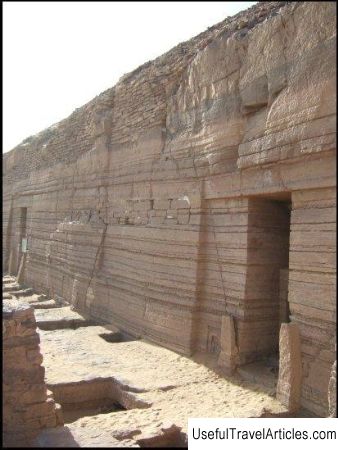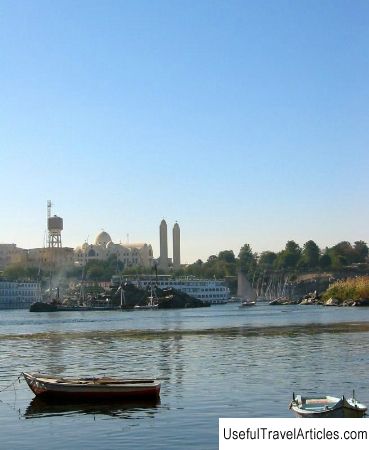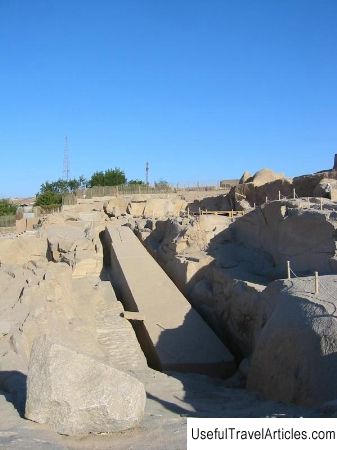Tombs of the Nobles description and photos - Egypt: Aswan
Rating: 7,8/10 (131 votes) 
Tombs of the Nobles description and photos - Egypt: Aswan. Detailed information about the attraction. Description, photographs and a map showing the nearest significant objects. The title in English is Tombs of the Nobles. Photo and descriptionAswan in ancient times was not a city, people during this period settled around the island of Elephantine, where the rulers and kings of Nubia lived. For this reason, the necropolis of the kings and royal family of Nubia was located nearby, next to the island, in what is today known as the tombs of the nobility in Aswan. The burials located in the West Bank of the Nile region are perfectly preserved and provide an opportunity to learn about history of Egypt in the period of the Ancient and Middle Kingdoms. They were discovered by the British archaeologist Lord Greenville in 1885 and became the first explorer of this important historical site. The tombs of the nobility in Aswan are called Gubad El-Hawa in some reference books, this is one of the most visited monuments in Upper Egypt. The frescoes inside are amazingly picturesque reflect the daily life of the ancient Egyptians and are a magnificent example of ancient art. The most important and beautiful are the tombs of Harkhuf, Sarenput II, Sabni and Mekkho. The entrance to the Mekkho tomb is carried out along diagonally carved steps - this technique facilitated the movement of the body of the deceased with the help of wooden and stone skates. Mekkho was a prince of the 6th dynasty of the Old Kingdom, the son of King Pepi II, who died in one of the royal trips. Inside the tomb, on the right wall, there is a fresco depicting the prince and his wife in traditional dress during an offering to the gods, as well as several other scenes from everyday life. It was customary in Ancient Egypt to decorate the first chamber of the tomb with scenes from the daily life of the deceased. Further to the right are false doors, and a few more frescoes. The burial chamber of the Mekho tomb is supported by 18 columns with many subjects and inscriptions, which are divided into three rows. One of the walls depicts a scene of Anubis and Osiris praying for Mekkho against the background of agricultural frescoes. The tomb of Sabni, son of Mekho, is a continuation of his father's tomb. A luxurious corridor, divided into two sections, leads to the burial, opening into a hall with 14 square columns and fishing scenes on all walls. An important feature of the tomb of Sabni is scenes telling about the history of the prince's journey for the body of his deceased father; this is one of the historical evidence of the peculiarities of the Egyptians' mentality during this period and their perception of life, death and immortality. Temple and tomb of Sarenput II - perhaps the best of the tombs of the nobility in Aswan. Sarenput II was the son of the Nubian king and crown prince, high priest of the temple of the gods Khnum and San, commander-in-chief of the Egyptian army during the reign of Amenmehat II (12th dynasty). The tomb begins with a courtyard supported by six columns, on the right side there is a granite slab bearing the name of the owner of the tomb. This is followed by a corridor with wall paintings dedicated to the life of the nobleman and his son. In another room with four columns, the titles of Sarenput II are indicated in hieroglyphic letters. The ruler of the island of Elephantine and the surrounding area, Harkhuf, who lived during the 6th dynasty between 2345 and 2181 BC. BC, was one of the first people buried in the tombs of the nobility in Aswan. His grave also has a traditional courtyard at the entrance, its facade is decorated with frescoes-biographies of a noble ruler,       We also recommend reading Archbishop's Palace of Lima (Palacio Arzobispal de Lima) description and photos - Peru: Lima Topic: Tombs of the Nobles description and photos - Egypt: Aswan. |




